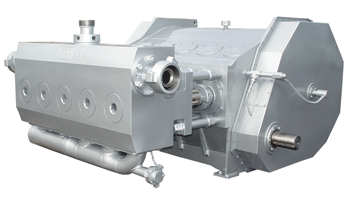
Developed in the early 20th century and made commercially viable mid-century, hydraulic fracturing is a vital process in the production of oil and natural gas in North America. Hydraulic fracturing is used to stimulate production rates of hydrocarbons by increasing the exposed surface area of geological formations, allowing greater flow of the reserves into the well bore.
The necessity of hydraulic fracturing has progressively increased as production rates on new wells continue to decline. In fact, most experts now project at least 90 percent of all future wells in North America will require some degree of fracturing to increase production results, with the majority of these operations occurring in shale gas formations. As demand for hydrocarbons increases, hydraulic fracturing will continue to be essential to meet the energy requirements in North America and around the world.
The pumping equipment used to transmit the fluid media down the well bore is key to the success of the hydraulic fracturing process. Reciprocating plunger pumps have been used for decades to propel a mixture of water, sand and chemicals into a well at pressures as high as 15,000 psi, and flow rates at times above 100 barrels per minute. The evolution of the frac pump has occurred throughout the history of hydraulic fracturing with pumps increasing in size, horsepower rating and pressure capabilities to meet the increasing demand of pressure pumping service companies as U.S. energy requirements push drilling into more complex geological formations to ensure supply.
Up to the early 2000s, frac pumps traditionally came in two types, triplex or quintuplex, and ranged in horsepower capacity from 1,300 to 2,000 bhp. The majority of fracturing operations took place on gas wells, almost entirely vertical in nature, requiring only one or two fracturing stages to complete the stimulation process. Being dependent on the formation's geologic makeup, pressure requirements were most often less than 10,000 psi. Pump design advancements during this time period were minimal. Pumps that had operated successfully for decades were capable of meeting the pressure and flow rate demands of the time.
The first dynamic shift in operation requirements for frac pumps occurred in the early 2000s with the widespread commercialization of the Barnett Shale unconventional resource play. The Barnett Shale represented a dramatic shift in pumping requirements, with horizontal drilling used for the first time on a wide scale as pumping pressures and operating times increased. This harsher pumping environment demanded stronger pumps capable of operating at pressures of 9,000 psi and pumping intervals of more than 8 hours. During the drilling boom of 2006 through 2008, well service companies in the Barnett Shale were pumping at nearly all hours of every day, putting increased stress on the pump power-end components as well as increased wear of expendable components, including the fluid cylinder.

Type of pump used in the Barnett Shale.
Pump manufacturers during the time began modifying existing pump models to improve the duty cycle and extend operating life in the harsher environment. For instance, one company introduced a "super duty" version of an existing successful quintuplex model that featured more robust fully-welded structural members, greater wrist pin bearing surface area, stronger steel construction and increased rod load capacity compared to previous pump designs. This modified quintuplex pump's increased flow rate and increased durability allowed pressure pumpers to push the envelope in the development of hydraulic fracturing techniques.
This modified pump and its triplex alternative were suitable for fracturing operations in the Barnett, yet the continuously progressing industry focused more on shale gas unconventional resources. In the last year and a half, frac pump manufacturers have seen another dynamic shift, which is now calling for further advancements in pump designs to meet ever-increasing demands on equipment. This shift can be credited to the further exploitation of unconventional gas reserves in North America, and in particular the Haynesville Shale in East Texas and Northern Louisiana, where well characteristics are pushing drilling contractors and pressure pumpers to limits never seen before on such a wide scale.
With the low permeability of these newer premium shale gas formations, new fracturing techniques have been developed in recent years to increase production rates to overcome the high costs of drilling and completion. Horizontal drilling and its associated multistage fracturing techniques have become the norm as shale formations have now become the leading sources of natural gas in North America. At the time of the writing of this article, the horizontal rig count is at an all time high, 659 rigs, or 49 percent of all U.S. operating rigs, up from 37 percent just one year ago, according to Baker Hughes.
The Haynesville Shale has put increased pressure on pumping equipment due to the severe pumping requirements of the wells. The average Haynesville wells are currently being fracced at pressures around 13,500 psi with frac stages numbering as high as 20 per well. In the Barnett, a pump may operate onsite for 6 to 8 hours, complete the job and then be returned to the shop for maintenance before being sent out on another job. In the Haynesville Shale, however, hydraulic fracturing operations might last several days with continuous pumping intervals of 3 to 4 hours and only a limited window between stages for rapid maintenance procedures while the next frac stage is prepared. These difficult operating conditions have required operators to place upwards of 50 percent spare horsepower capacity onsite to instantly replace any equipment that may fail during operation, whether it is the engine, transmission or pumping system. In addition to increased pressure requirements, Haynesville wells often require extremely hard synthetic proppant (sand). The new synthetic proppant, such as bauxite, wear pump expendable components and fluid ends at increasingly rapid rates.
The Haynesville Shale represents a major challenge for frac pump manufacturers. Pumping service companies demand a pump that can operate in a greater working envelope with no sacrifice on pump lifespan. Pump manufacturers are currently developing products to meet these challenging demands through innovative design features and new developments in pump expendable fabrication.
The challenge is to provide greater reliability and maintenance predictability, reducing the product downtime at frac sites and the user's need to have significant excess pumping equipment available to ensure continuity of pumping in the unlikely event of equipment failures. Manufacturers are responding to these requirements by evolving existing, well-established products, and in parallel, integrating new clean-sheet innovations and design programs with the latest computer analysis and simulation tools. Design engineers must further enhance the mechanical integrity of the frac pump to support higher pumping pressures, ensuring longer times between maintenance events, and making the maintenance activity itself safer, easier and faster.
For instance, one manufacturer has taken an existing frac pump and completly redesigned the power frame geometry, allowing an increase in rated maximum rod load while at the same time reducing its weight. The strength of the steel alloy forging used to manufacture the fluid cylinder was enhanced to provide greater fatigue life, while the geometry of the fluid end was further optimized to increase the rigidity. The pump's stay-rods were completely redesigned to reliably accommodate the additional loads. The increase in rod load allowed the pump to be comfortably rated at 2,400 bhp. This new horsepower capability was confirmed through intensive durability testing during which the pump was subjected to nearly 10 percent above the rated loads for much of the test's duration. The cylinder spacing, crankshaft stroke and all the geometry around expendable components was untouched during the redesign to ensure that the changes had no impact on currently accepted maintenance processes. This also allows the fluid end assembly to be retrofitted onto older power ends.
As the global demand for natural gas continues to grow, new pumping technologies must be developed to ensure service companies can efficiently operate in more intense geological formations. Innovation has always been the key to success in the oilfield.

